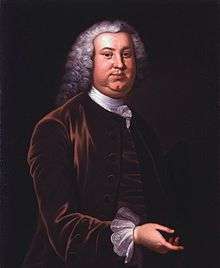First Virginia Convention
The First Virginia Convention was an extralegal meeting of the House of Burgesses held in Williamsburg, Virginia from August 1–6, 1774.
Background

Presiding officer
Tensions which would boil over into the American Revolution had been rising for some time between Massachusetts and Great Britain. Following the passage of the Tea Act on May 10, 1773, which allowed the East India Company to sell tea directly to the Thirteen Colonies and threatened the livelihood of American merchants, the Sons of Liberty in Boston destroyed a shipment of tea in a protest which came to be called the Boston Tea Party. In response, on March 25, 1774, the Parliament passed the Boston Port Act, blockading the port of Boston to all maritime trade.
The House of Burgesses, the colonial legislature of Virginia, approved June 1, 1774 as a day of "Fasting, Humiliation and Prayer" in a show of solidarity with the people of Massachusetts. The governor of Virginia John Murray, 4th Earl of Dunmore reacted by dissolving the Burgesses.
Meeting
.jpg)
In defiance of Dunmore,[1] the Burgesses moved to Raleigh Tavern where they constituted themselves as the First Virginia Convention on August 1.[2] The Convention declared its support for Massachusetts and called for a congress of the Thirteen Colonies, the First Continental Congress, to which it also elected delegates. It further banned commerce and payment of debts with Britain, pledged supplies to Massachusetts, and elected officers, including its president, Peyton Randolph, previously the speaker of the House of Burgesses. Before dissolving on August 6, the Convention selected representatives to the Second Virginia Convention.
Notable attendees
- Patrick Henry
- Richard Henry Lee
- Francis Lightfoot Lee
- Richard Bland
- Peyton Randolph
- George Washington
- Benjamin Harrison V
See also
References
- "House of Burgesses:Prologue to Revolution". Encyclopedia Virginia.
- "This Week In History: First Virginia Convention". Colonial Williamsburg Foundation.
